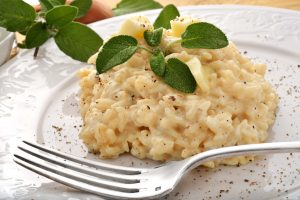Sage (garden sage – Salvia officinalis) belongs to the labiate family / lamiaceae. Sage is derived from the Latin “salvare”, which means “to save/heal”. This is why sage was also called the salvation of the world and was believed to give eternal life.
It is said that the sage gave life to at least four thieves who plundered corpses without fear of infection during the plague epidemic in Toulon, France, in 1630. The aldermen granted the thieves their lives on condition that they reveal their secret of how they had protected themselves from infection, namely with germicidal sage vinegar. (We will tell you the recipe for this below.) Even today it is popularly said: “Sage in the garden, death can wait.”
Sage has anti-inflammatory, bactericidal, wound-healing, stimulating, antiperspirant, stomach-strengthening and antispasmodic properties. British neuroscientists have discovered that sage oil can also improve memory performance and is helpful in the treatment of Alzheimer’s disease.
Internally, sage is used mainly for excessive sweating, digestive problems and diarrhoea and for weaning. Externally, sage is used as a gargle for inflammation of the mucous membranes of the mouth and throat, as an ointment for lip herpes or in oral and dental care (chew a sage leaf raw or massage teeth and gums with a sage leaf).
The bitter substances of sage make fatty foods more digestible and prevent flatulence. Sage can be used as tea, tincture, in oil, fresh, dried, powdered, in vinegar or even in wine. The fresh or dried leaves are suitable for seasoning meat dishes (e.g. lamb) and soups, or you can work the sage into a bread dough. Like thyme, sage can extend the shelf life of food.
Recipes with sage:
Sage vinegar – The recipe of the 4 thieves:
Pour 1 tablespoon each of dried sage, thyme, lavender and rosemary into ¾ litres of cider vinegar, leave to stand for 2 weeks, shake regularly, then strain.
Use: as a spice, as a gargle for colds (diluted 1-2 tablespoons to 1 glass of warm water), for rubbing on the chest and back in case of colds (also stimulates blood circulation)
Sage foot bath:
Refreshes and deodorizes strained and swollen feet, regularly used it regulates sweating.
Add 1 pot of strong sage tea to the foot bath water, alternatively add 10 drops of sage oil mixed with 1 tablespoon of milk, cream or honey to the foot bath.
Nasal drops:
Bring 250 ml of water to boil, dissolve ¼ to ½ teaspoon rock salt in it, add ½ teaspoon dried or 2 teaspoons fresh ground ivy, 1 teaspoon dried or 4 teaspoons fresh sage, cover and leave to stand for 10 minutes, strain and pour into a brown glass bottle with eyedropper. Can be stored in a cool and dark place for about 2 weeks. For relief in case of colds or hay fever.
Sage liquor:
Pour ¾ l fruit brandy (e.g. cherry, pear, plum brandy) over 25 g fresh sage leaves and a small bunch of thyme or wild thyme, add about 25 g rock candy and leave to stand for 6 weeks, then drain and enjoy by liqueur glasses as a precaution against colds.
Sage wine:
In 1 l of good red wine, steep 20 g of dried sage leaves for about 8-10 days, then pour into a dark bottle and keep in a cool place. In case of indigestion with flatulence or a feeling of fullness, drink a shot glass full.
 Sage risotto:
Sage risotto:
Heat the mixture of 1 tablespoon of oil and 3 tablespoons of clarified butter, sauté 1 chopped onion and some sage leaves in it. Add 300 g round grain rice, roast through, deglaze with some white wine. As soon as the white wine has evaporated, pour in beef stock or meat/vegetable stock, salt and let it boil down for about 20 minutes, stirring again and again. Finally, fold in 3 tbsp. finely grated Parmesan cheese and leave to stand for another 5 minutes.








